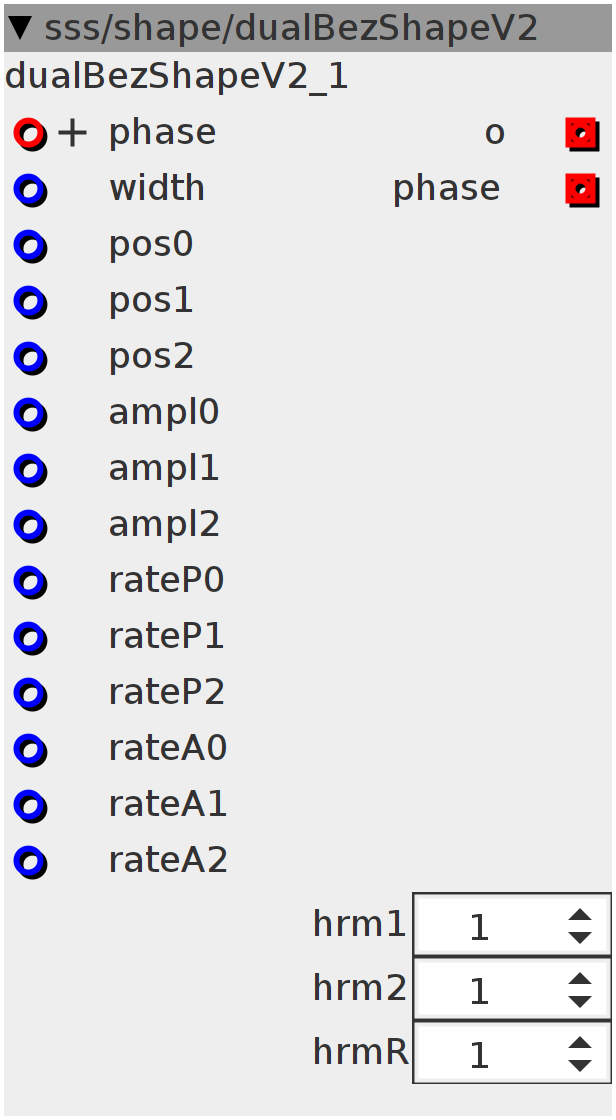dualBezShapeV2
dual bezier curve shaper. One for position, the other for level. This version has "rate" added to the modulation options. With these you set the vector-rates at each point.
Inlets
frac32buffer.positive Phase Input
frac32 width
frac32 Parameter 1a
frac32 Parameter 1b
frac32 Parameter 1c
frac32 Parameter 2a
frac32 Parameter 2b
frac32 Parameter 2c
frac32 rateP0
frac32 rateP1
frac32 rateP2
frac32 rateA0
frac32 rateA1
frac32 rateA2
Outlets
frac32buffer output
frac32buffer phase
Parameters
int32 hrm1
int32 hrm2
int32 hrmR
int32_t prev;int32_t step = (inlet_width - prev) >> 4;
int32_t width = prev;
prev = inlet_width;{
int32_t P1 = inlet_phase;
P1 = (P1 * param_hrm1) & ((1 << 27) - 1);
int32_t P2 = inlet_phase;
P2 = (P2 * param_hrm2) & ((1 << 27) - 1);
width += step;
int32_t I0 = ___SMMUL(width << 3, inlet_pos0 << 2);
int32_t I1 = ___SMMUL(width << 3, inlet_pos1 << 2);
int32_t I2 = ___SMMUL(width << 3, inlet_pos2 << 2);
int32_t J0 = ___SMMUL(width << 3, inlet_ampl0 << 2);
int32_t J1 = ___SMMUL(width << 3, inlet_ampl1 << 2);
int32_t J2 = ___SMMUL(width << 3, inlet_ampl2 << 2);
int32_t Ri0 = ___SMMUL(width << 3, inlet_rateP0 << 2);
int32_t Ri1 = ___SMMUL(width << 3, inlet_rateP1 << 2);
int32_t Ri2 = ___SMMUL(width << 3, inlet_rateP2 << 2);
int32_t Rj0 = ___SMMUL(width << 3, inlet_rateA0 << 2);
int32_t Rj1 = ___SMMUL(width << 3, inlet_rateA1 << 2);
int32_t Rj2 = ___SMMUL(width << 3, inlet_rateA2 << 2);
int(x1) = P1;
int(y1) = ((128 << 20) - P1);
int p0 = (int64_t)I0 + ___SMMUL(Ri0 << 2, P1 << 2);
int p1 = (int64_t)I1 + ___SMMUL(Ri1 << 2, P1 << 2);
int p2 = (int64_t)I2 + ___SMMUL(Ri2 << 2, P1 << 2);
int p3 = (int64_t)I0 - I1 + ___SMMUL(Ri0 + Ri1 << 2, P1 - (1 << 27) << 2);
int p4 = (int64_t)I0 + ___SMMUL(Ri0 << 2, P1 - (1 << 27) << 2);
int x2 = ___SMMUL(x1 << 3, x1 << 2);
int x3 = ___SMMUL(x2 << 3, x1 << 2);
int x4 = ___SMMUL(x3 << 3, x1 << 2);
int y2 = ___SMMUL(y1 << 3, y1 << 2);
int y3 = ___SMMUL(y2 << 3, y1 << 2);
int y4 = ___SMMUL(y3 << 3, y1 << 2);
int a = ___SMMUL(y4 << 3, p0 << 3);
int b = ___SMMUL(x1 << 4, ___SMMUL(y3 << 3, p1 << 3) << 1) * 4;
int c = ___SMMUL(x2 << 4, ___SMMUL(y2 << 3, p2 << 3) << 1) * 6;
int d = ___SMMUL(x3 << 4, ___SMMUL(y1 << 3, p3 << 3) << 1) * 4;
int e = ___SMMUL(x4 << 3, p4 << 3);
int f = (inlet_phase + a + b + c + d + e) & ((1 << 27) - 1);
f = (f * param_hrm2) & ((1 << 27) - 1);
int(r1) = f;
int(t1) = ((128 << 20) - f);
int q0 = (int64_t)J0 + ___SMMUL(Rj0 << 2, f << 2);
int q1 = (int64_t)J1 + ___SMMUL(Rj1 << 2, f << 2);
int q2 = (int64_t)J2 + ___SMMUL(Rj2 << 2, f << 2);
int q3 = (int64_t)J0 - J1 + ___SMMUL(Rj0 + Rj1 << 2, f - (1 << 27) << 2);
int q4 = (int64_t)J0 + ___SMMUL(Rj0 << 2, f - (1 << 27) << 2);
int r2 = ___SMMUL(r1 << 3, r1 << 2);
int r3 = ___SMMUL(r2 << 3, r1 << 2);
int r4 = ___SMMUL(r3 << 3, r1 << 2);
int t2 = ___SMMUL(t1 << 3, t1 << 2);
int t3 = ___SMMUL(t2 << 3, t1 << 2);
int t4 = ___SMMUL(t3 << 3, t1 << 2);
int g = ___SMMUL(t4 << 3, q0 << 2);
int h = ___SMMUL(r1 << 4, ___SMMUL(t3 << 3, q1 << 3) << 1) * 4;
int i = ___SMMUL(r2 << 4, ___SMMUL(t2 << 3, q2 << 3) << 1) * 6;
int j = ___SMMUL(r3 << 4, ___SMMUL(t1 << 3, q3 << 3) << 1) * 4;
int k = ___SMMUL(r4 << 3, q4 << 2);
int l = (inlet_phase * param_hrmR + g + h + i + j + k) & ((1 << 27) - 1);
int32_t r;
SINE2TINTERP(l << 5, r)
outlet_o = (r >> 6);
outlet_phase = l;
}